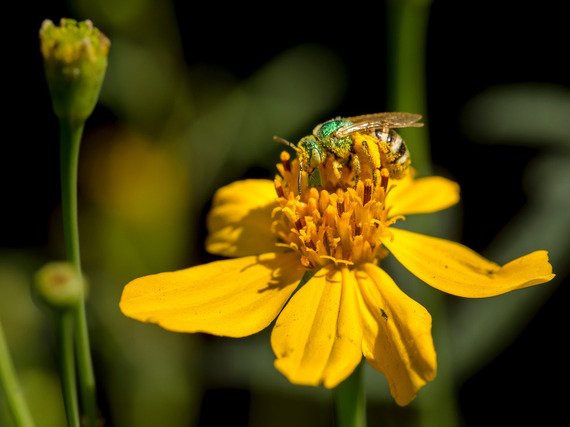-and-
USDA’s Conservation Effects Assessment Project and Auburn University investigated whether native bees preferred flowers based on things like flower size, color, scent, nutritional quality and time of bloom. Knowing these preferences can help farmers, conservationists and gardeners fine-tune a seed mix that will attract and benefit specific species to increase the chances that “if you plant it, they will come.”
Source: U.S. Department of Agriculture
y Laura Crowell, Natural Resources Communication Specialist (Photo: Courtesy)
A study by Auburn University in collaboration with USDA assessed the wildflower preferences of native bees in the southeastern United States and revealed three key favorites. Findings offer significant insights to inform pollinator habitat seeding decisions across the U.S.

Pollinators, like native bees, need habitat including native wildflowers, flowering trees, and other plants to survive. Knowing which wildflower seeds to include in a pollinator mix can be a guessing game based on local climates, soil types, and desired pollinator species. USDA’s Conservation Effects Assessment Project (CEAP) and Auburn University collaborated on a study to help determine which wildflower species to plant when seeking to attract and conserve key pollinators in the Southeast. Study results, published in June 2024, indicated native bees have some clear favorites.
Planting a Pollinator Field of Dreams
Wildflowers vary in attractiveness to bees because of flower size, color, scent, nutritional quality, and time of bloom. This recent CEAP study sought to investigate the floral preferences of native bees to 18 planted wildflower species. Limited information exists about the degree to which bees are attracted to recommended plant species and knowing these preferences can help farmers, conservationists, and gardeners fine-tune a seed mix that will attract and benefit specific species to increase the chances that “if you plant it, they will come.”
“These findings will help pollinator habitat decision makers develop the seed mixes with the best chance of maximizing benefits to the highest possible number of native bee species, maximizing the potential ecosystem service benefits provided by pollinator habitat,” said Charlie Rewa, CEAP Wildlife Lead with USDA’s Natural Resources Conservation Service (NRCS).

Setting up the Sweeping Study
Researchers developed a grid of 72 square meter sub-plots, each surrounded by buffers that were 1.5 square meters in size. Mature potted plants of 18 wildflower species, were each transplanted into four sub-plots. (A list of wildflower species can be found in Table 1 of the report). The wildflowers were selected based on the following criteria:
- Recommended by USDA to attract native bees
- Bloom during spring, summer, or fall
- Easily available for purchase in the southeastern U.S.
During the data gathering period of May to November 2019, researchers counted a total of 155,185 flowers. At any given time during the study, between three and 16 wildflower species were simultaneously in bloom, providing foraging bees a choice of wildflowers to visit.
-and-
Through sweep netting surveys, researchers captured 1,024 bees, representing 26 genera and three families. The majority, 63%, represented the family Halictidae that are more commonly known as “sweat bees”. Bees were counted weekly, during a two-day period, on warm, sunny days with lower chances of precipitation, i.e. when bees were active. Surveyors rotated between morning, midday, and afternoon and spent a total of 7,740 minutes sweep netting the 72 sub-plots. The study found that each bee taxon, or major species category, visited an average of four wildflower species, and each plant species on average was visited by six bee taxa.

Native Bees Share Three Common Favorite Wildflowers
Researchers learned three wildflower species, Butterfly weed (Asclepias tuberosa), Indian blanket flower (Gaillardia pulchella), and Blue vervain (Verbena hastata), attracted the greatest abundance, richness, and diversity of native bees in the southeastern U.S., compared to the other wildflower species. These three wildflowers attracted 89% of all bee taxa in the study, indicating their importance to native bees.
“Anyone looking to establish pollinator habitat for the purpose of supporting native bees should research whether any of these three plants are appropriate for their growing zone,” said Anthony Abbate, Auburn University’s lead on the study. “Our study findings imply these species will provide the most ‘bang for your buck’ in the Southeast.”
According to Abbate, an additional important take home from the study is several wildflower species attracted few bees, but those species were uncommon or pollen specialists. Including the wildflower species that attracted these bees in a seeding mix could be important for conservation efforts to benefit rarer or pollen specialists since they are more vulnerable to disturbances than compared to generalist bees.
Based on the study results, Auburn researchers worked closely with NRCS and the Xerces Society to develop a special seed mix designed to be highly attractive to bees. The mix, selected for the southeastern U.S., contains a diversity of wildflower and native grass seeds with overlapping bloom periods (See mix is listed in Table S6 of the report.)

Learn More and Find Your Local Service Center
NRCS offers financial assistance and many resources to support pollinators, including the CEAP wildlife page. Your local NRCS office may offer pollinator habitat recommendations for your specific area and can provide free technical assistance for establishing pollinator habitat to meet your individual needs and goals. You may find contact information for your local NRCS office by selecting your state and county in our Service Center Locator.
NRCS also offers conservation financial assistance through voluntary conservation programs, like the Conservation Stewardship Program and Environmental Quality Incentives Program, for eligible producers to support implementation of NRCS conservation practices.





